This was published 5 years ago
Belgium travel guide and things to do: 20 reasons to visit
By Brian Johnston
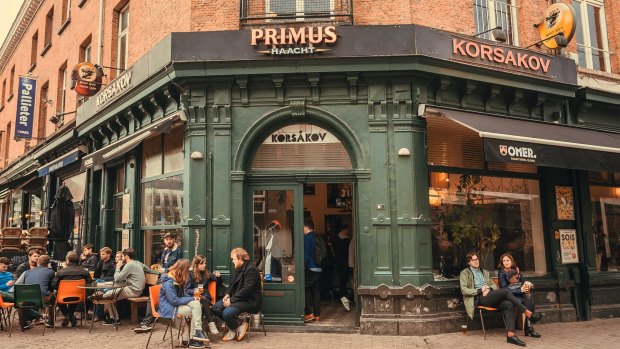
People enjoying a beer in an old popular bar in Antwerp, Belgium.Credit: Shutterstock
1. SEE EUROPE CONDENSED
Belgium packs in a typically European assortment of cuisines, cultures and languages and, like the continent itself, is divided into a Germanic north and Latin south. It has played a role in European history far out of proportion to its size. You'll find great variety, superb architectural heritage, good art museums and, with a few exceptions, far fewer tourist crowds than elsewhere in Europe. See visitbelgium.com
2. DISCOVER BEGUINAGES
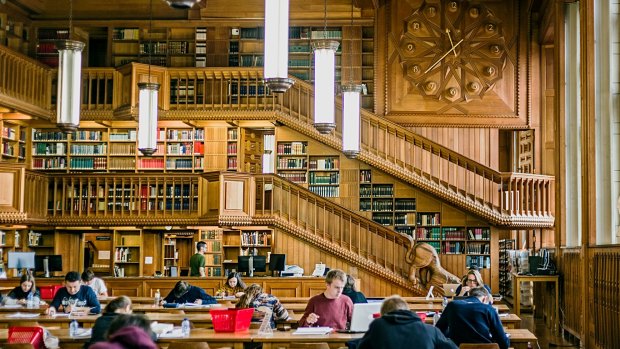
Students studying inside the library of the university of Leuven, Belgium.Credit: Shutterstock
Beguinages are old convent-like architectural complexes, almost exclusively found in the Low Countries, in which religious women lived in self-sustaining collectives and were remarkably independent. Towns across Flanders have well-preserved beguinages featuring chapels, breweries, bakeries, hospitals and other buildings in beautiful, gated compounds. The ones in Bruges, Ghent, Mechelen and Leuven are among those that are World Heritage listed. See visitflanders.com
3. ADMIRE ART NOUVEAU
Brussels is notable for art nouveau architecture, one of the great masters of which was Belgian architect and designer Victor Horta, whose World Heritage-listed work is seen across the capital. Tassel House is considered the world's first true art nouveau building. Horta's own house is now a museum devoted to the influential architect; the lovely art nouveau building is complemented by artworks and period furnishings. See hortamuseum.be
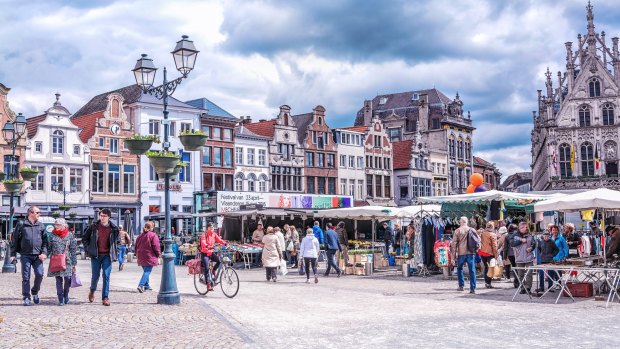
Grote Markt in Mechelen (Malines), Belgium.Credit: Shutterstock
4. LIVE THE STUDENT LIFE IN LEUVEN
Flanders' oldest university town is home to 50,000 students, so no surprise this small city has great beer, cheap eats, an energetic nightlife and creative vibe. Visit the University Library's wood-panelled, Harry Potter-esque reading room and climb its historic tower for great views. Then kick back on Oude Markt square, where the outdoor terraces of 42 bars are a meeting point for all Leuven. See visitleuven.be
5. BASE YOURSELF IN MECHELEN
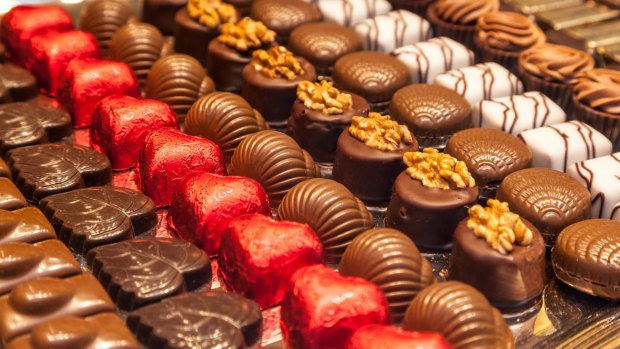
Traditional Belgian pralines in a shop window in Brussels.Credit: Shutterstock
Belgium has an excellent train service, and you could see a chunk of its historic sights on day trips from centrally located Mechelen, a handsome historic town in its own right, with a wonderful main square, 300 listed monuments, buzzing cafe life and good boutique hotels. St Rumbold's Tower above the cathedral provides a fantastic clamber that allows you to get right in among the bells. See visit.mechelen.be
6. EXPLORE THE MUSEUM OF FINE ARTS
The Musées Royaux des Beaux-Arts in Brussels is especially good for Flemish Primitives and Old Masters. All the greats are represented, with particularly splendid canvasses by Rubens. Don't miss the section devoted to local lad Rene Magritte, either. The Belgian surrealist had a liking for painting everyday objects such as bowler hats, apples and seagulls in unusual contexts. See fine-arts-museum.be
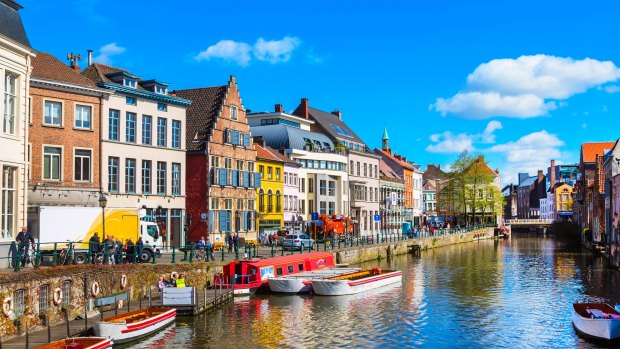
Gorgeous Ghent, Belgium.Credit: Shutterstock
7. MEET THE BOURGEOISIE
So much of historical Europe focuses on royalty and aristocracy, but in Belgium you'll get a refreshing look at the emerging merchant and middle classes of the medieval and Renaissance period in towns that have a long history of proud republicanism and independence. Old towns aren't dominated by intimidating architecture but by more intimate market squares, guild houses and public buildings. See visitbelgium.com
8. DISCOVER WALLONIA
While most Australians have heard of Flanders, few are familiar with Wallonia, the mostly French-speaking southern half of Belgium. The region has interesting old cities such as Namur and ecclesiastical centre Tournai, fine smaller towns such as Bouillon and flower-decked Durby, and the rugged countryside of the Ardennes for hiking and biking. The Meuse Valley and Waterloo battlefield are other attractions. See walloniabelgiumtourism.co.uk
9. VISIT NAMUR'S CITADEL
The riverside capital of French-speaking Wallonia is topped by a whopping, many-tiered hilltop fortress, added to over many centuries, that Napoleon nicknamed the Anthill of Europe. It's so large a little tourist train trundles visitors around, though its rampart footpaths are worth walking. Tour the underground passages, visit the interpretive centre and admire views over the old town that lies under its mighty battlements. See namurtourisme.be
10. HAVE A SPA
The town of Spa became so famous in the 18th century that its name became a generic term for any hydrotherapy resort. Spring water bubbles up everywhere and is harnessed into swimming pools, wellness retreats and fountains. In between curative dips you can visit the 1763 casino (probably the world's oldest), attend music festivals or take in a Formula One race at the Spa-Francorchamps circuit. See spatourisme.be
11. MIX OLD WITH NEW IN GHENT
With one of northern Europe's most magnificent old towns, now almost completely pedestrianised, Ghent has plenty of historical and cultural kudos, but is equally a major industrial centre. That makes it a lively contemporary city with an energetic student life, vibrant food and beer scenes, and abundant boutique shopping: a great place to balance sightseeing with up-to-date local flavour. See visit.gent.be
12. TUCK INTO BRUSSELS
Lively Rue des Bouchers and the alleyway Petite Rue des Bouchers, nicknamed "the stomach of Brussels", are packed with a great choice of modestly priced, very popular restaurants that highlight the city's ethnic variety, from French to Spanish and South American. Tuck into moules frites (mussels with French fries) if you're after the classic Belgian meal. See visit.brussels
13. INDULGE IN CHOCOLATE
Make haste to the shops of Belgium's top chocolate makers. Leonidas tempts with chocolate-coated marshmallows and caramelised almond sticks, while Godiva has limited-edition truffles that run to exotic flavours such as lemongrass and coconut, or rum and lime. Neuhaus and Frederic Blondeel are two top must-try brands. You'll also find several chocolate museums, a chocolate academy and tour companies offering chocolate-themed walks. See visitflanders.com
14. PAUSE IN FLANDERS' FIELDS
The WWI battlefields of Flanders such as Ypres and Passchendaele are perhaps the most moving of all war destinations, not least because the mass graveyards, with their clipped lawns and rows of white gravestones, are visually compelling. Museums and monuments also tell the story of the Australians and others who fought and died here. The last post at Menin Gate is unbearably moving. See visitflanders.com
15. BE THERE OR BE SQUARE
At the heart of Brussels' old town, Grand-Place is a masterpiece of age-old woodwork, Flemish gables and an abundance of gilt. It's one of Europe's most impressive Renaissance squares, intact but for a few baroque and neo-Gothic flourishes. The town hall (which houses the tourist information office) is especially magnificent. Free concerts, a flower market and cafe terraces ensure you'll spend plenty of time here loitering without intent. See visit.brussels
16. CHILL OUT IN MONS
Mons glammed itself up in 2015 as European Capital of Culture but has always had a lively atmosphere. Its cafes and late-night bars are especially buzzing at weekends, with Grand-Place (the main square), Place au Marché aux Herbes and Rue d'Havré the epicentres of bar-hopping and people-gazing. The historic Belfry District fulfils old-town expectations, while the modernist cube of fine-arts museum BAM hits contemporary buttons. See visitmons.co.uk
17. WANDER BRUGES
Belgium's most famous tourist destination can get crowded, but you'll still be seduced by this old town sitting astride swan-paddled canals and packed with beer gardens and chocolate shops. Gothic belfries, gabled houses and cobbled squares are well preserved. Stay overnight for the quieter evening atmosphere and the excellent contemporary dining scene – 15 restaurants have Michelin stars. See visitbruges.be
18. GET MUSICAL
The Museum of Musical Instruments in Brussels provides a wonderful look at 8,000 musical instruments from across the world – the world's largest such collection. You can put on headsets at the displays and hear the instruments being played, from ancient Egyptian pipes to Tibetan bone flutes and modern synthesisers. If you've ever wondered what a dulcimer sounds like, here's your chance to find out. See mim.be
19. GRIN AND BEER IT
Belgium started brewing in the 12th century, and has some of the best beer in the world. It has over 200 breweries, six still run by Trappist monks. Leuven is considered the beer capital thanks to its gigantic Stella Artois brewery (which you can tour), but every town and region offers interesting craft varieties, served in their own distinctively branded and shaped glasses. See visitbelgium.com
20. RELAX IN ANTWERP
Antwerp, once a leading centre for trade and art, and graced with a fine old town, is overlooked in comparison with Bruges or Ghent. It's a significant port town with a gritty, lively appeal and reputation for interesting shopping. If you enjoy local life there's no better place to be on a summer evening, since Antwerp's downtown core is packed with cafés, bars and nightclubs. See visitantwerpen.be
Brian Johnston was a guest of Visit Flanders, Wallonia Tourism and Scenic.
Sign up for the Traveller Deals newsletter
Get exclusive travel deals delivered straight to your inbox. Sign up now.